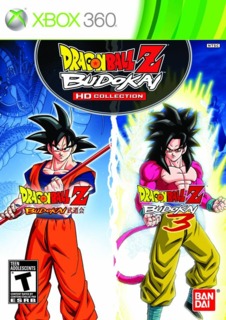This collection is a good investment for people who never had a chance to play these games before.
Even though the Budokai games were a trilogy on the PS2, this HD collection only includesDragon Ball Z Budokai and Dragon Ball Z Budokai 3, so that ponders the question: Where isDragon Ball Z Budokai 2? It is an HD collection after all, and all of the games were on the PS2, so you would expect it to be there. Namco Bandai's official statement on the matter is thatDragon Ball Z Budokai 2 was "more than a fighting game," as it introduced elements that broke away from the focus of fighting. Even so, it would have been nice to have included that in the package, as it is to celebrate the series – no matter how different they are from one another. This collection, then, is to introduce the birth of Budokai, by including the first title, then following up with Dragon Ball Z Budokai 3 acting as the swan song of the series and, as it stands, is the highest -rated Dragon Ball Z title of all-time.
Being able to experience the first in the Budokai series is a good insight to see how far the games have come, but when you have the third instalment that refined the Budokai games to their finest, then the first game seems a little meaningless to play and serves only as a history lesson or a playthrough if you never got to touch it back in the day. Included gameplay modes are Story, Duel and World Match. If there is one advantage this game has over Dragon Ball Z Budokai 3, it is that it tells a deeper story, with more fancy cutscenes and a linear progression that helps keep players focused on the plot. Dragon Ball Z Budokai only covers up to the Gohan vs. Cell battle, so it makes sense to flesh out the story as much as possible to make it last longer. With only 23 characters in its roster, Dragon Ball Z Budokai is lacking some of the later cast of heroes and villains, and that makes it another reason why you will want to stick withDragon Ball Z Budokai 3 instead.
The core mechanics between the two games are roughly the same. Fighting is on a 2D plane, but you can sidestep to dodge incoming beam attacks. Characters attack with the punch, kick or Ki buttons, and have the fourth button to guard against attacks. To improve on the combat, the original developers, Dimps, decided to give the option to use special moves without having to use them as an end-move to a combo string. This means you can randomly throw out Kamehamehas and other moves when you have enough Ki metre to do so. Fighting in Dragon Ball Z Budokai 3 feels more polished, refined and flashier (check out those new mechanics they put into Dragon Ball Z Budokai 3) than its predecessor, but for people who are used to newer fighting games, you might find the fighting system a little old and clunky.
Dragon Ball Z Budokai 3 is also jam-packed with content. Not only do you have 42 characters, but the storyline stretches all the way up to the end of the Dragon Ball GT saga and also includes some characters from the movies. The story mode, called Dragon Universe, includes a world map that consists of tasks that must be accomplished to continue with the plot. Light RPG mechanics are introduced to give you a chance to grow the characters to how you like to play them. Like throwing out beam attacks? Then increase the Ki attribute. Multiple characters can also be used in this mode, and with different unlockables available that change the outcome of the story, you can end up spending a lot of time with Dragon Universe due to its replayability.
These re-mastered titles do not come with any additional content, so the only thing you are getting that was not in the PS2 versions are the trophy unlocks. Everything in the game but the menus is in widescreen, and the games are not stretching to a 16:9 ratio either, so this creates a genuine widescreen display. Graphically, Dragon Ball Z Budokai is very plain and does not look great with the HD make up. Dragon Ball Z Budokai 3, on the other hand, looks incredible sharp and smooth. That game gets away with a solid look because of the improved anime-inspired, cel-shading style that translates well into HD. The backgrounds are lacking, but overall, for a shift to HD, it looks as I would have expected it to without a graphical enhancement. It also keeps the framerate rock solid.
This collection is a good investment for people who never had a chance to play these games before. It comes with a different aura compared to the newer Dragon Ball Z games on PS3 and Xbox 360, which tried to blend in a cinematic experience with the fighting gameplay, but in doing so ended up creating a fighter that felt less involving and took away time from the player. Fans will enjoy returning to this faithful, if barebones, transition to HD and will be a worthy if you do not feel too bummed about the second game not been included. As for me, Dragon Ball Z Budokai 3 is my favourite Dragon Ball Z game purely because it tried to keep it simple, without adding too much of the fancy stuff, but still managing to capture the over-the-top action of the show. What Dragon Ball Z Budokai 3 comes down to is me and my pals playing a solid and fun fighting game without any interruption. If you want that with your Dragon Ball Z game, then you should check out this HD collection.

